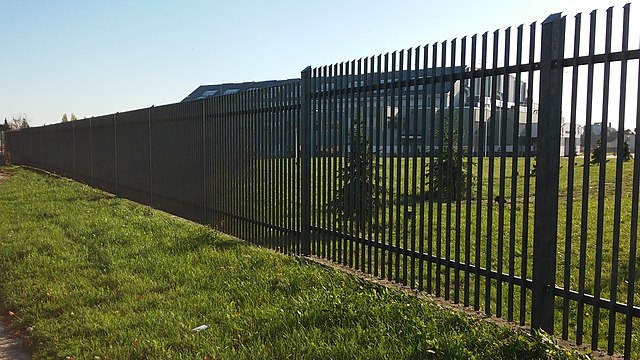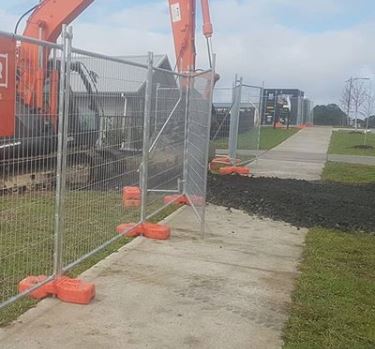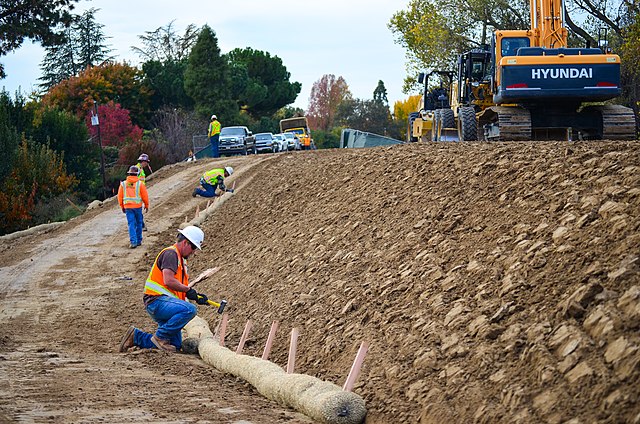
Erosion can cause a lot of damage to commercial and residential properties in Ocean and Monmouth County, New Jersey. If you’re looking for a way to prevent soil loss and instability on your land, you might want to consider using straw wattles. This natural material is made of straw or coir, wire, and twine, and it can be installed in a variety of ways to help with sediment control.
There are a variety of ways to install straw-filled wattle. In this article, we’ll teach you how we install them properly so you can start protecting your property today.
What Are Erosion Control Wattles And How Are They Used For Erosion Control
According to the Ocean County Soil Conservation District, construction of housing, commercial and industrial developments, and other land-disturbing activities have accelerated the process of soil erosion and sediment deposition, causing water pollution in New Jersey and harm to domestic, agricultural, industrial, and recreational, fish and wildlife, and other resource uses. Rapid changes in land use, from agricultural and rural to non-agricultural and urbanizing uses, have also sped up the process of soil erosion, sediment deposition, and the need for stormwater management control services.
Straw wattles are used by erosion control services like ours as an effective erosion prevention tool. They are a natural material made of straw, wire, and twine. They are used primarily on slopes that may not have much vegetation or other cover to prevent of bare soil from eroding. Until a protective grass combination establishes itself along the levee’s slopes, the temporary wattles are utilized to assist prevent stormwater runoff. The mixture is intended to help protect the slopes from further erosion once it has sprouted. Erosion can cause a lot of damage to your property, so using straw wattles is a great way to prevent it.
There are a variety of ways to use straw wattles for erosion control. One way is to install them as a perimeter control fence almost like retaining walls. You can either create a fence out of straw wattles by yourself or hire someone to do it for you. Another way to use them is as a mat. You can place them directly on the ground where there is soil erosion or you can put them in between plants as a stable mulch to help keep the soil around the roots in place and protect them from being damaged.
The benefits of using straw wattles for erosion control
There are a number of benefits to using straw wattles for erosion control. One of the most important is that they are a natural material. This means that they are environmentally friendly and will not damage the earth as some man-made materials can.
Additional benefits of using straw wattles for erosion control include:
- They can be installed in a variety of ways, including as a fence or a mat.
- They are an effective way to prevent soil from eroding.
How to install a straw wattle fence
The first step in installing straw wattles is to decide where you want to put them. You can put them in between plants to help protect them from being damaged, or you can place them directly on the ground where there is soil erosion. Once you’ve decided on a location, use a shovel to dig a trench that is at least six inches deep.
Next, take the straw wattles and place them in the trench. Make sure that they are laying flat and that the wire and twine are facing up. Once they are in place, use soil to fill in the trench around the straw wattles. This will help hold them in place and keep them from moving.
If you’re using straw wattles as a fence, make sure that there is at least 18 inches of space between each wattle. You can either create a fence out of straw wattles by yourself or hire someone to do it for you.
How to install straw wattles as a mat
If you’re using straw wattles as a mat, make sure that they are placed directly on the ground where there is soil erosion. You can also place them in between plants to help protect them from being damaged. To do this, cut the straw wattles into 12-inch pieces and then fold them in half so that the wire and twine are facing each other.
Once you have folded the straw wattles, use landscape pins to secure them in place. Make sure that the pins are pushed all the way into the ground so that they hold the mat firmly in place.
Do Straw Waddles Help Soil Compaction?
Straw waddles are a popular tool used to prevent soil compaction, often found in farming settings. Also known as a wattle barrier, straw waddles consist of straw stuffed into interwoven or straw netting and then laid in rows over the trampled ground. Straw waddles are believed to be effective erosion control ideas because the straw fibers act like an absorbent sponge, trapping water that can reduce compaction of the underlying soil.
The straw acts as a cushion, also protecting the ground beneath by absorbing impacts from tractor tires or animals walking on top of it to prevent erosion. Furthermore, straw waddles can help with weed control when they are harvested and replaced periodically throughout the growing season and can eventually contribute organic matter to the soil when they decompose. It is clear that straw waddles have many uses beyond just controlling soil compaction.
Tips for maintaining your straw wattle fence
If you’ve installed a straw wattle fence, it’s important to make sure that you maintain it properly.
Here are some tips for keeping your fence looking good and functioning well:
- Check the fence regularly to make sure that the straw wattles are still in place and that the wire and twine are not damaged.
Replace any straw wattles that are damaged or missing.
- If the fence is covered in snow, make sure to remove it so that the straw wattles can get sunlight.
- If the fence is wet, make sure to dry it off so that the straw wattles will not rot.
The straw rolls, or “wattles,” are erected to aid native grasses in establishing themselves on the recently renovated properties. Their removal is one of the last phases in rehabilitating construction damaged land to it’s preconstruction state.
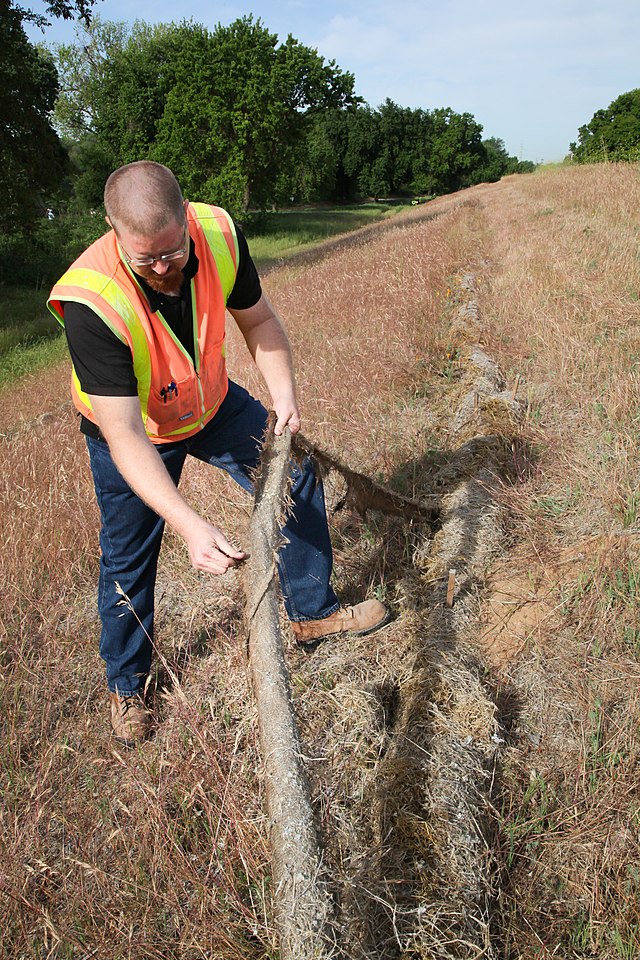
Final Thoughts About How Straw Wattle Is Used For Erosion Control
We are Eastcoast Site Work, your reliable New Jersey erosion control company specializing in the use of straw wattles for effective soil protection. Straw wattles are eco-friendly materials crafted from straw, wire, and twine, designed to safeguard your property from the damaging effects of erosion. Our team at East Coast Site Work is committed to providing top-notch SWPPP services for all your present and future projects.
Straw wattles offer versatile options for erosion control, allowing for installation as a fence or as a mat. These wattles can be positioned directly on areas prone to soil erosion, or placed between plants to reduce stormwater runoff damage.
As an erosion control solution, straw wattles present several advantages:
- Environmentally friendly materials
- Flexible installation methods
- Effective prevention of stormwater runoff-induced soil erosion
At Eastcoast Site Work, we provide a range of erosion control services, including:
- Erosion control blankets (Menards)
- Erosion control tubes
- Straw socks
- Straw tackifier
- Straw waffle
- Straw wattles (Tractor Supply)
Trust Eastcoast Site Work to protect your property from the harmful effects of erosion.
Get A Quote For Your New Jersey Construction Site Work Project
Call 732-370-0291 or Contact Us Now
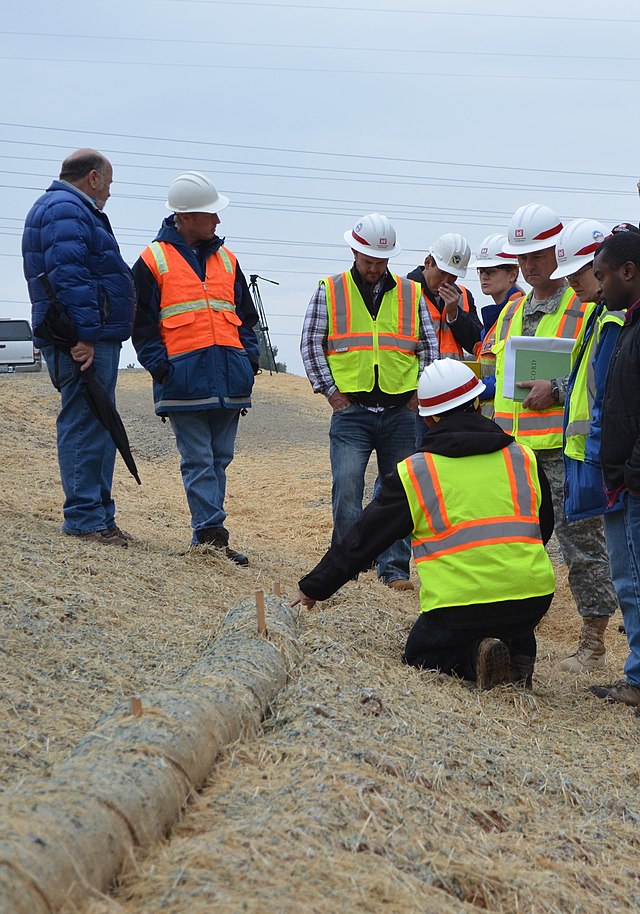
Frequently Asked Questions
Q: What are curlex sediment logs?
A: A curlex sediment log is a type of erosion control product made from recycled shipping pallets. They are used in a variety of applications, such as stabilizing steep slopes, protecting shorelines, and controlling erosion around culverts and bridges.
Q: What is silt fence?
A: Silt fence is a type of erosion control product made from a woven fabric that is placed around construction sites. It is used to prevent sediment from leaving the site and causing environmental damage.
Q: What is polymeric netting?
A: Polymeric netting is a type of erosion control product made from a plastic mesh. It is used to stabilize slopes and prevent soil erosion. It is also sometimes used as a temporary fence around construction sites.
Q: Can wood chips be used for erosion control?
A: Yes, wood chips can be used for erosion control. They are often used in mulch to create a weed-free area and to keep the soil moist by adding organic material. Wood chips can also be used in conjunction with other products, such as silt fence, to provide additional erosion control.
Q: What is straw tubes erosion control?
A: Straw tubes erosion control and erosion control tubes are a landscaping technique that uses straw bales to help prevent soil erosion. The straw bales are placed in strategic locations to help protect the soil from rain and wind erosion. They also help to retain moisture in the soil, which helps to keep plants healthy.
Q: Straw wattles vs silt fence
A: Straw wattles and silt fences are both used to control sediment, but they work in different ways. A straw wattle is a bundle of straw or hay that is lashed together and placed in the path of flowing water. The wattle catches the sediment and slows down the flow of water, which gives the sediment time to fall out of the water. A silt fence is made from a wire frame covered with a layer of geotextile fabric. The fabric catches the sediment and prevents it from passing through.
Q: Is a DIY straw wattle possible?
A: Yes, a DIY straw wattle is possible. A straw wattle is an earthen wall made by interlocking bundles of dried reeds or straw.
To make a DIY straw erosion control waddle, you will need:
- a bundle of dried reeds or straw (try to find reeds or straw that are about the same size)
- a sturdy string or rope
- a pair of scissors
- something to mark your desired height with (like a pencil or marker)
Additional Resources
- How and when to use an erosion control blanket
- You can read more about What is a retention pond and why is maintenance important in this post.
- Types of Soil Erosion and Mitigation Strategies
- Do You Need a Portable Temporary Fence for Your Construction Site?
- Read about What is Soil Stabilization in Road Construction in this post
- Why choose hydroseeding to establish a lawn instead of sod or dry grass seeding?
- When To Use An Erosion Control Silt Sock
- How does Vegetation Help Stabilize Slopes and Prevent Erosion?
- Silt Fence Best Practices for Stormwater Management

